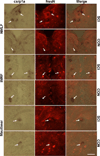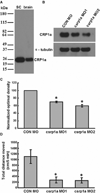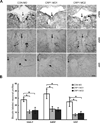Cysteine- and glycine-rich protein 1a is involved in spinal cord regeneration in adult zebrafish
- PMID: 22288476
- PMCID: PMC4442618
- DOI: 10.1111/j.1460-9568.2011.07958.x
Cysteine- and glycine-rich protein 1a is involved in spinal cord regeneration in adult zebrafish
Abstract
In contrast to mammals, adult zebrafish have the ability to regrow descending axons and gain locomotor recovery after spinal cord injury (SCI). In zebrafish, a decisive factor for successful spinal cord regeneration is the inherent ability of some neurons to regrow their axons via (re)expressing growth-associated genes during the regeneration period. The nucleus of the medial longitudinal fascicle (NMLF) is one of the nuclei capable of regenerative response after SCI. Using microarray analysis with laser capture microdissected NMLF, we show that cysteine- and glycine-rich protein (CRP)1a (encoded by the csrp1a gene in zebrafish), the function of which is largely unknown in the nervous system, was upregulated after SCI. In situ hybridization confirmed the upregulation of csrp1a expression in neurons during the axon growth phase after SCI, not only in the NMLF, but also in other nuclei capable of regeneration, such as the intermediate reticular formation and superior reticular formation. The upregulation of csrp1a expression in regenerating nuclei started at 3 days after SCI and continued to 21 days post-injury, the longest time point studied. In vivo knockdown of CRP1a expression using two different antisense morpholino oligonucleotides impaired axon regeneration and locomotor recovery when compared with a control morpholino, demonstrating that CRP1a upregulation is an important part of the innate regeneration capability in injured neurons of adult zebrafish. This study is the first to demonstrate the requirement of CRP1a for zebrafish spinal cord regeneration.
© 2012 The Authors. European Journal of Neuroscience © 2012 Federation of European Neuroscience Societies and Blackwell Publishing Ltd.
Figures








References
-
- Becker CG, Becker T. Adult zebrafish as a model for successful central nervous system regeneration. Restor Neurol Neurosci. 2008;26:71–80. - PubMed
-
- Becker T, Wullimann MF, Becker CG, Bernhardt RR, Schachner M. Axonal regrowth after spinal cord transection in adult zebrafish. J Comp Neurol. 1997;377:577–595. - PubMed
-
- Bernhardt RR. Cellular and molecular bases of axonal regeneration in the fish central nervous system. Exp Neurol. 1999;157:223–240. - PubMed
Publication types
MeSH terms
Substances
Grants and funding
LinkOut - more resources
Full Text Sources
Medical
Molecular Biology Databases
Research Materials
Miscellaneous

